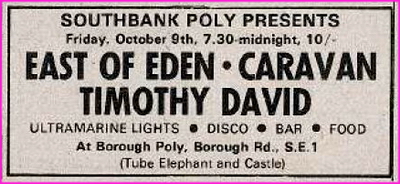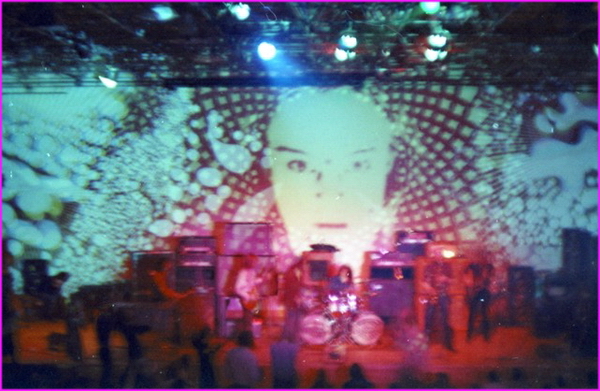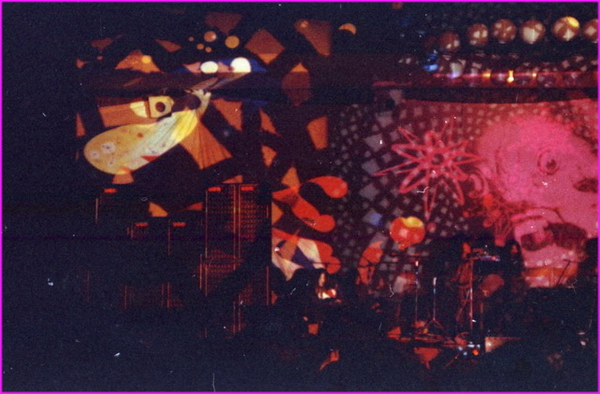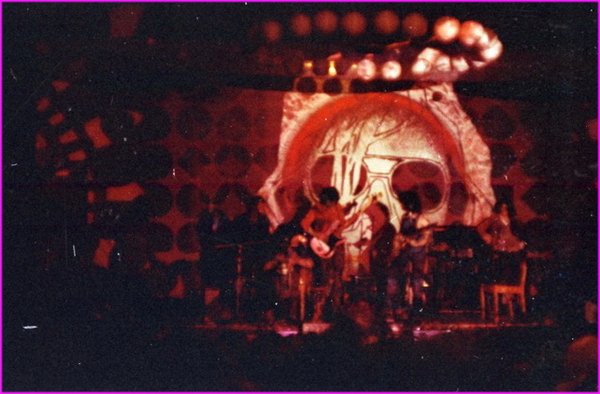Tim Seaman created the Ultramarine Lightshow.
These notes are as accurate as I can remember but in the unlikely event of errors or omissions, I apologise, it was fifty years ago!
How you got into doing Light Shows & when?
I saw “the Floyd” at a big Charity Concert at the Royal Albert Hall, “Only Joking”, December 12th, 1966. I was 15 years old.
They started the second half with the hall in complete in darkness, and the light and sound were like nothing I have seen or heard before. In respect of the lighting, I thought “I should be able to do that” and set about building something and developing a range of liquid light techniques and lightboxes.
Initially one projected liquid light. Individual blocks of spot bulbs for each performer to throw multicoloured shadows onto a white back drop, and variable speed colour wheel boxes to colour wash the backdrop. More on the equipment later.
The project started with David Price, who was the money, and bought our first new projector. After a trip to San Francisco David dropped out of the show to do his own thing, and I was joined by Richard Callan, who designed and built our stage light ‘organ’, and another, at that time rival show (Paul Davies, Phil Vernon and Gus Thompson) who had the equipment but not the technique.
An electronics genius named Lawrie Ball started to make electronics to control the stage rig, out of scrapped telephone equipment.
The Ultramarine Lightshow was born.
Where did/does your Light Show operate?
Word of mouth at first, from lighting school bands at first, local church halls and then through an agency that booked many of the Universities and Colleges in the South of England.
Our biggest problem was that we were schoolkids. Later on, we were recommended for both the Roundhouse and Lyceum residency, by bands we had worked with, but were not taken seriously because of our age.
At this stage a very large acknowledgement must be given to Dulwich College School, Dulwich, London for their encouragement, loan of equipment (vast resource) (Mr Jones without whom…. we would never have got as far as we did), the use of the chemistry lab after hours (Thanks, Mr Facer, an explosives expert in a former life), the photo lab, and the technology department for the resources to make the ‘machines’.
Who was your main influence, if any?
I read that “if you want to be good, copy the best that everyone else does and develop your platform from there”.
So, the Pink Floyd as their show developed, Mark Boyle with the Soft Machine, the lighting of Zoot Money’s Dantalians Chariot (a bit of a one trick pony),
Eric Burden after the Animals for the use of strobes, I had tickets #2-6 for both nights of the Doors and Jefferson Airplane at the Round house – Glen MacKay’s Headlights, and Joshua Light Show/Joe’s Lights when they came over with the Chambers Brothers at the ICA. Plus, the Op Art work of Bridget Riley, Pop Art of Roy Lichtenstein and Andy Warhol, and the end sequence of 2001 a Space Odyssey.
London had a Cinerama cinema, and if you sat in the first rows you got total immersion, which we tried to achieve in our Light Shows.
Very quickly we worked out that there was a dichotomy between lighting the band, and putting on a show. We always carried our own stage lights to light the band.
The big difference between then and now was power. None of the halls were that big, and yesterday’s standards of relatively low powered stage lights were adequate for the individual members of the band to be illuminated effectively
What Bands have you worked with?
Working with bands is not so easy to define. Pretty much without exception we were booked in our own right to create the environment and to match the music of the band as necessary.
Two of the bands listed below asked us to become their light show but we did not pick up on either for reasons which should become clear. We worked harder on certain bands than others, developing a series of light sets to match the likely music.
Lighting to fit the music of the band was imperative.
The Ultramarine Light Show did not just switch on and let it go. When the band came on the focus changed.
The list includes:
Aardvark, Atomic Rooster, Blonde on Blonde, Brinsley Schwarz, Caravan, Curved Air, David Bowie, East of Eden, Fanny, Gloria Gaynor, Groundhogs, High Tide, John Hiseman’s Colosseum, Juicy Lucy, Killing Floor, Matthews Southern Comfort, Mott the Hoople, Pink Floyd, Random Hold, Steamhammer, Stoneground, Swinging Blue Jeans, T Rex, Uriah Heap, Van Der Graf Generator, Yes.
We were regularly booked for High Society balls and parties to create the psychedelic environment.
Towards the end we were booked to do The Who, but this show was cancelled because The Who had started to carry their own lighting. The writing was on the wall.
What was your most memorable gig?
Either Jon Hiseman and Curved Air at Bath University, or Yes at Maidstone Art College, the full Monty, all guns blazing. We knew the venue, the music, had rehearsed the effects for every possible song, and really “sent up rockets”. But all shows where the band engaged with us during their show, when they liked what we were doing with the lights. Marc Bolan was great.
What other Light Shows have you worked with and/or Cooperated with?
None really, although we did get invited to join a Lightshow cooperative, Richard and I attended one meeting, nice people, did not smoke the dope, and decided it was not really for us.
Where did the name(s) come from?
The show started as Mollweide’s Homographic Projection
“The Mollweide projection is an equal-area pseudocylindrical map projection displaying the world in a form of an ellipse with axes in a 2:1 ratio. It is also known as Babinet, elliptical, homolographic, or homalographic projection. The projection is appropriate for thematic and other world maps requiring accurate areas.” (Wikipedia)
It’s the way you see maps of the world when laid flat. Clearly too much of a mouthful.
When David Price left, we dropped the name for codename Ultramarine (Super Seaman) and the name stayed with us till the end.
When was your Light Show formed?
We did our first shows in 1967, and ran till around 1972 when some of us finished College or had taken up other jobs. We needed money for more and better equipment to make the show bigger and better and the bigger bands were carrying their own lights.
Throughout all of this, all of us were at school or students at University.
How long did it run for? (is it still going or maybe back after an interval?)
The Lightshow has not performed since 1973 although I have provided lighting design for bands, built discotheque lighting with Richard and done theatre work from time to time. However, I could quickly rebuild the show and I have recently discovered much of the projection equipment, liquid light glass and slides in a lock up.
Why did we stop and not take offers to join the bands? Then, the Light show was halfway between the band and the road crew. We designed it, built it, performed it, packed it up and drove it home, occasionally being hit over the head with a mike stand by a careless singer after he had kicked over a stage light box, and if anything went wrong with the sound system, the Lightshow was always unreasonably blamed.
Whilst gigging with the bands was great fun, when we wanted to do it, Richard and I got more from the creativity, each show introduced something new. With the same band we would need to repeat show after show. Joining one of “our bands” could have been fun for me, but not for the others. I made my choice and absolutely don’t regret it.
It would have been nice to light The Who or Jim Hendrix but that didn’t happen.
Any personnel changes within the Light Show(s)
We generally had a core team of six which was augmented by girlfriends and ‘drivers’ (friends with a van)
So what happened?
I, Tim Seaman, got a bachelor’s degree in electrical engineering and lighting, after which I was hired by Thorn Lighting the inventors of the Q-File, the first computerised control system for TV and Theatre Lighting.
As a project Manager I travelled the world, designing, and installing systems for television, theatre and concert halls. I designed the special effects (flashing light controls) for the original MGM (now Bally’s) and the Desert Inn (rebuilt as the Wynn) in Las Vegas.
I left the lighting industry in 1981.
Richard Callan joined the BBC and remains a good friend.
Paul Davies, and I believe Phil Vernon, became Architects, then, but all contact is now lost.
Gus Thompson joined the Supertramp roadcrew.
Can you supply behind the scenes photo’s of the equipment/shots from live shows/Posters/Personnel pictures/Light Show Handbills etc?
Probably but they will need to be recovered, over time.
What equipment you started out using, why you used it and what you changed to?
How many projectors/slide machines you started out with?
Start:-
Rank Tutor 500 – liquids
2x Aldis magazine projectors – slides and colour wheels
Wired remote controlled stage lights set, one box of three lights per band member (max 5)
3x variable speed colour wheel screen washers.
How many projectors you finished up with?
Finish:-
6 x rank Tutor 1 – liquid projectors
2 x Tutor 2 projectors with custom made liquid and other wheels
2 x Kodak Carousels – environment projectors (photographs on which effects were overlaid)
4 x Aldis magazine slide projectors – patterns, with colour wheels
2 x Overhead projectors – Clock glasses and oils
2 x Special effects projectors with rotating prisms for image movement
2 x Movie projectors
On stage Band member lights, electronically controlled for light switching, including band volume driven and drumbeat impact.
2 x Zenon Strobe lights
2 x traditional spotlight sidelights.
2 x UV floods
What non standard objects/items were used in the quest for 'better effects'?
Nothing was standard for us. All the liquid light effects were initially derived from chemical reaction developed in the lab at school. It was only later that we realised that as the Tutor projectors warmed up, the liquids bubbled from the heat on their own. We only used heat slides for some of our liquid lights as the heat was hard to control, glass cracked, and liquids dried up if you left them a moment too long. So, chemicals, pumps (from fish tanks), injection syringes and variable speed wheels were used to vary our range of liquid effects.
Anything that had a clear pattern was photographed, developed into black and white slides. (shades of grey eliminated). Colours were introduced by colour wheels, prisms and polarisation.
Both pressured (between two clock glasses), floating oil and injected liquids were used on the overheads
What is your favourite aspect of doing Light Shows (maybe you prefer liquids, slides, movie clips for example)
We tried to create the right environment and accompaniment for the band’s music. We used different effects to suit lively bands and static bands. Carrying stage lights, we were able to illuminate the band without the effects, which made them very happy as at that time just projected lights could leave the band in darkness. Whilst we carried movie projectors they were deemed the least effective and rarely used.
Where has your career taken you if you are not still in the Lighting Industry?
After lighting I took a post graduate busines diploma (compressed MBA). Then completed a successful varied business career in the video and computer aided design industries.
I now turn my hand at photography and cooking where I try to apply the same creativity that I did in the ‘60s.
Tim Seaman - September 3rd 2021 |




